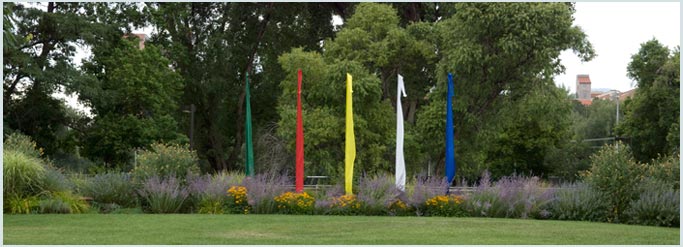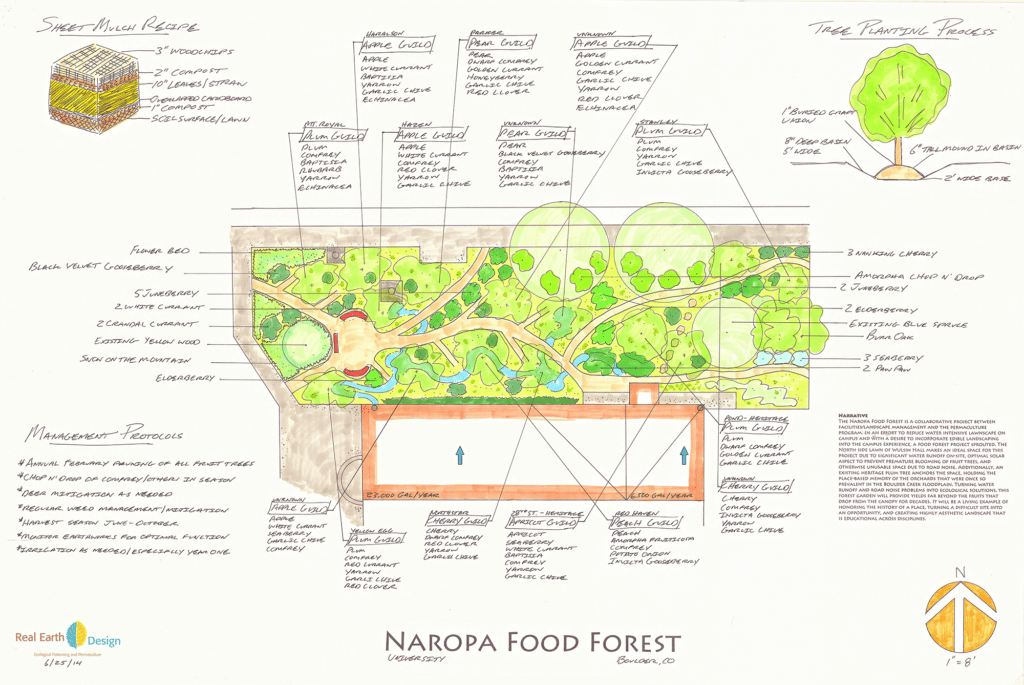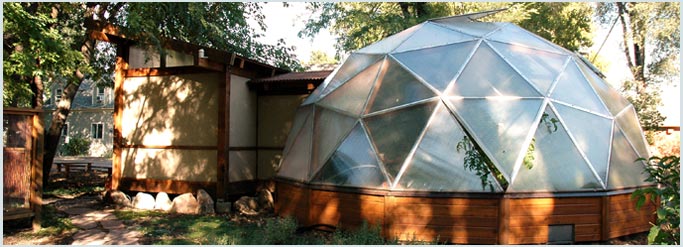Grounds & Landscaping

Always innovative and seeking to improve, Naropa University currently uses the following approaches to eco-landscaping:
- Composting all plant material.
- Creating habitat for bees and pollinators.
- Never using any “cides” – no pesticides, herbicides, etc.
- Planting many edible and medicinal plants.
- Using products that are biodegradable and/or organic.
- Always incorporating principles of permaculture.
- Actively working to improve water conservation by upgrading and modifying existing irrigation systems.
- Incorporating new technology at the Paramita Campus, such as subsurface irrigation linked to an on-site weather station that supplies water to the lawn and gardens only in the proper quantities and only at the proper times. By delivering water directly to the root zone, evaporation is all but eliminated. In what is known as “fertigation,” organic liquid fertilizers also flow through the irrigation system, delivering minute and constant levels of fertilizer throughout the growing season, which improves plant health and reduces maintenance.
- Phasing out the use of fossil fuel equipment by purchasing electric mowers and trimmers, as well as through the use of biodiesel for the maintenance truck and bobcat.
Edible Landscaping
At Naropa we incorporate edible and medicinal plants into the landscape to engage the community and contribute to a regenerative, sustainable ecosystem. With edibles, the landscape becomes more personal, interactive, and bountiful. Many of the plants serve as food and habitat for bees and pollinators and several Naropa classes utilize the edible landscape for teaching and coursework.
Below are maps of most of the edible and medicinal plants on our campuses.
Naropa Food Forest
Food Forest Plans (click to enlarge)

Naropa Food Forest Design Plan
William D. Jones Community Greenhouse
An Expression of Naropa's Commitment

The greenhouse enhances learning opportunities built around horticulture methods, permaculture, ecological system sciences and environmental philosophies such as deep ecology. In addition, it provides plants for campus landscaping, vegetables for the Naropa Café, and seedlings for the Boulder community. As a tangible manifestation of Naropa University’s environmental commitment, the greenhouse inspires the community to both learn more and do more to foster a healthy relationship with nature.
The Naropa University Greenhouse Project was initiated by eight students in the fall 2006 Advanced Applied Horticulture class, who envisioned a campus that could exemplify alternative food production methods. Excitement grew, and some of those students carried the project beyond the “class project phase,” introducing it to the greater Naropa community. As the buzz spread, members of the Environmental Studies Department, Facilities, Office of University Advancement, Operations and adjunct faculty members signed on to help, making the project a community effort. A site near the Naropa Tea House was chosen for construction of the greenhouse, which was completed in fall 2008. Its grand opening celebration took place on Earth Day 2009, featuring a talk, “Growing Strong Communities: Lessons from the Naropa Community Greenhouse,” by former ombudsman for the U.S. Environmental Protection Agency, Robert Martin.
After much research, project members settled on a geodesic dome design. Delivered as a kit and assembled on site, the greenhouse is 22 feet in diameter, has an interior area of 379 sq. ft., and reaches a height of 10′ 10″. In addition, permaculture design philosophy guided construction of the interior. For example, growing space was maximized through stacking methods and self-sufficiency has been achieved via a one thousand gallon aquarium that moderates temperature and provides fertilizer. With the inclusion of a subterranean heating system and solar panels, the structure is 100 percent self-sustaining.
Permaculture Lab
Design
The permaculture instructor and students manage the greenhouse to be a sound example of permaculture principles in action. Management practices strive to make as many connections between different features as possible.
One example of this is that the greenhouse has a wintertime deficiency of warmth and carbon dioxide. There is also a surplus of slugs and sow bugs, which are detrimental to plants. Adding domestic quail to the greenhouse accomplishes management of these needs and surpluses, as the quail provide body heat and carbon dioxide to the greenhouse, and will also eat the slugs and sow bugs. In this way, the problems become solutions, as they suggest an available niche in the ecology, and by adding quail, additional yields of eggs and meat are obtained.
Plants


